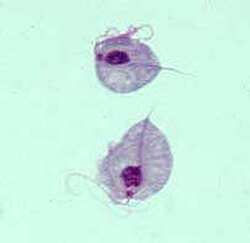709 2017 1147 Fig6l
Autor/Urheber:
Thomas Cavalier-Smith (caption slightly moved, digitylly enhanced)
Attribution:
Das Bild ist mit 'Attribution Required' markiert, aber es wurden keine Informationen über die Attribution bereitgestellt. Vermutlich wurde bei Verwendung des MediaWiki-Templates für die CC-BY Lizenzen der Parameter für die Attribution weggelassen. Autoren und Urheber finden für die korrekte Verwendung der Templates hier ein Beispiel.
Shortlink:
Quelle:
Größe:
734 x 984 Pixel (74108 Bytes)
Beschreibung:
Cytoskeletal innovations during loukozoa origins. Ancestral condition in loukozoa summarized as represented by Malawimonas. Upper shows the whole cell seen from the right with the feeding groove tilted obliquely to show left and right mt roots (R1, R2) that support feeding groove rims and floor. Younger anterior cilium (C2) with oar-like beat and older posterior cilium (C1) undulating from base to tip simultaneously propel the cell forward (arrow) and waft food into the groove for ingestion. Lower diagram views the cell apex from the ventral side (so the cell’s right is on the left) to show mt arrays (colour: mt bands R1–R3; plus a dorsal fan of diverging mts that support the cell’s dorsal surface) and associated fibrous supports (black: A–C, I). The orthogonal centrioles (anterior A, posterior P) are interconnected by asymmetric linkers and in loukozoa (left) a dorsal mt fan and anterior left mt band (R3) connect C2s to the apical dorsal plasma membrane. R3 is developmental precursor of R1. The ancestral loukozoan interposed novel alveoli between the plasma membrane and dorsal fan, which split into a right bypassing mt band (BB) and numerous single, diverging subpellicular mts attached to alveolar inner faces.
The text argues that developmentally and evolutionarily the singlet root (S, brown) is a specialised R2 subcomponent, not a third posterior root as traditionally assumed. Dorsal fan and apical mts are actually longitudinal (as shown for BB only); the purple line symbolises a cross section of their mt arrays.
Lizenz:
Credit:
Fig. 6 (left) at https://link.springer.com/article/10.1007/s00709-017-1147-3 Kingdom Chromista and its eight phyla: a new synthesis emphasising periplastid protein targeting, cytoskeletal and periplastid evolution, and ancient divergences. In: Protoplasma 255, pages 297–357,doi:10.1007/s00709-017-1147-3
Relevante Bilder
Relevante Artikel
ExcavataDie Excavata sind ein Taxon, das als super-group zu den Eukaryoten gestellt wird. Zu ihnen gehören ausschließlich einzellige Organismen, die ausnahmslos begeißelt sind. Innerhalb der Euglenozoa gibt es Formen mit Chloroplasten, die entsprechend Photosynthese betreiben. .. weiterlesen


